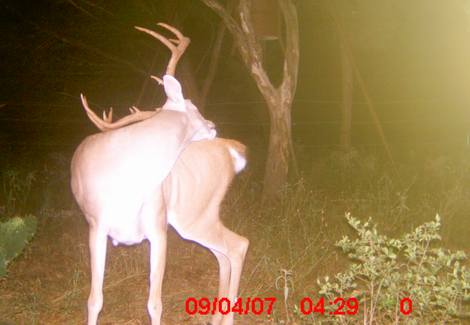The digital game camera really has given hunters one of the best scouting tools available for white-tailed deer and other game, but most users fall short of using their camera to its potential. The game camera can be a great tool for seeing what’s out there, but like any tool, it must be used properly for the user to get the full benefit of using the “hunter that never sleeps.”
First and foremost, a digital game camera will let you see many of the bucks you have available for harvest in the area where you hunt. Most of the bucks you probably would have never seen otherwise. The most common practice employed by game camera users is to set a camera adjacent to their feeder or food plot. Although this usually gets hunters lots of pictures, all it really tells you what deer are present.
You’re probably thinking, “Well, if I know a certain buck is coming to my feeder, then I will just sit there and wait for him.” But, if you really intend for the camera to help you not only get a look at your deer, but also want it to help you bag “your” buck, then you will have to get a bit more creative, so pay attention.
By keeping your camera/s moving, such as to different locations, trails, watering areas, etc, you can get a better idea of which bucks are using which trails — and at what time of day — thus helping to pattern your buck. This data then allows you to identify the area where a specific buck is spending the majority of his time. We’ve all had this happen before: You see a really nice buck prior to the season, but then once hunting season kicks in the buck just seems to have disappeared. At first you think that maybe someone else has lucked out and tagged the big boy, but then camera photos after the season show that he is in fact still there. So what gives?
Bucks may avoid certain areas at times (like when you’re there), but they will not abandon their home range alltogether. So, to gain more knowledge about the habits of the bucks or a specific buck in your area, you will want to set out your cameras in various locations, but of course not just randomly through the woods and hills. Yes, mineral blocks and feeders will allow you to rapidly photograph a large number of deer, and that will give you a better handle of what is available, but you still need to identify a particular area to hunt for your buck.
Once hunting season starts and people enter the woods, the deer know you are there. You may be very careful going into and out of your hunting area, but you are likely not the only hunter in a buck’s home range. With that said, bucks will not behave the same into the hunting season as they have prior to the season, especially in areas with high hunting pressure. What you need to learn is where the buck you are looking for is when he’s not at the feeder. He has to move and he has to eat, but you want to find out how he gets from point A to point B and where to intercept him.
Be very specific when placing out your cameras. If there are deer trails between areas of good bedding cover and food sources, these are places you definitely want to investigate. Also, patches of woods with thick cover or areas that people/hunters avoid all together should be examined. Deer can pattern you too, you know.
A good place to set up your game camera would be over a deer scrape. Scrapes are like magnets to white-tailed bucks and does — and scrapes will serve to concentrate the activity of deer moving through an area. With a scrape you know exactly where the deer will be, so getting a high quality picture of the deer is not a problem.
In addition, look for funnels when placing your camera out. Funnels can be either natural or man-made. Funnels can include anything from strips of woods, areas where larger wooded areas narrow down, overgrown fence lines, river bottoms, or even roadways through thick cover. Deer can be lazy, too. Of course, it’s usually when you’re not there — but at least you will have the photos!
Also, don’t overlook water holes and creek crossings. Deer will frequent water holes, especially during hot weather, and deer know where to find reliable water. Once you get away from a stable water supply, deer spread out in the woods and the movement of indiviudal animals become more difficult to predict. Water sources are great places to hunt prior to the rut. Use your camera/s to cover as many trails as possilbe and you will be surprised at what you find.

Should I put my trail camera low or high on a tree?
Brandon, I would suggest placing your camera about 4 foot off the ground and at a slight downward angle, especially if you are using a flash camera. Your flash will become more effective as is reflects off the ground, allowing it to better light the area.
I make sure I put my cameras a little higher in the tree so people or other things like coyotes can’t take them down!